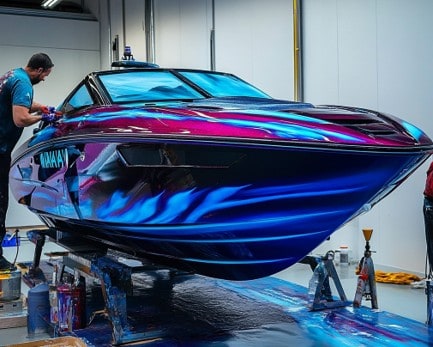A fresh coat of paint can transform a boat in more ways than one. While it certainly boosts the visual appeal—whether you want a mirror-like shine on a classic fiberglass hull or prefer a bold color that shows off your personal style—painting also acts as a protective shield. Modern primers are engineered to prevent corrosion, repel moisture, and extend the overall lifespan of your boat. Investing in a quality paint system isn’t just about aesthetics; it’s a vital step in preserving a valuable asset.
How do I know when it is time to paint my boat?
Loss of Gloss: If your gelcoat no longer stays shiny for the entire boating season—even after waxing and buffing—it may be time to upgrade with paint.
Visible Damage: Chips, dings, and dock rash can become glaring eyesores and expose the underlying material to further harm. Painting after proper repairs helps conceal damage and protect the hull.
Obvious Wear: Fading, cracking, blistering, or peeling are strong indicators that your current paint or gelcoat is on its last legs.
Deck Wear: High-traffic areas such as decks often wear down faster. If you notice the finish thinning in spots, consider repainting before the problem gets worse.
By addressing these issues sooner rather than later, you’ll avoid bigger, more expensive fixes in the future.

How Often Should I Repaint My Boat?
The timeline depends on several factors, including usage and environment.
Heavily Used Boats: If your boat spends a lot of time fishing, sailing, or cruising in harsh saltwater conditions, the paint will wear out faster. Expect to repaint more frequently.
Freshwater & Light Use: Boats that live in gentler environments—such as lakes or calm bays—and see less frequent outings might keep their finish longer.
Quality of Maintenance: Regular cleaning, polishing, and occasional touch-ups go a long way in extending the life of any paint job.
Below-Water Fouling Control: Antifouling paint often requires an annual inspection or refresh, although some premium multi-season products can last a couple of years. Regular maintenance here keeps your hull efficient, avoiding marine growth and drag.
Steps Involved in Painting a Boat
Consult a Professional: If you are not sure you want to do the work yourself then it is best to talk to a reputable boatyard or experienced painter about your objectives, budget, and timeline.
Surface Preparation: Properly cleaning, sanding, and priming the surface is key. If there’s existing damage, it must be repaired first. Filler or extra primers may be needed to create a smooth base.
Priming: Using the correct primer is essential. It not only provides a better bond for the paint but also serves as an additional layer of protection against water intrusion or corrosion.
Topcoat Application: This is where skill really matters. A well-applied topcoat delivers the gloss, color, and UV resistance that keep your boat looking fresh.
Finishing Touches: Buffing, polishing, or any decorative details (like stripes, graphics, or lettering) come last. Quality topcoats and finishing techniques ensure the paint will look amazing and last.
Remember, the cost of skilled labor typically exceeds the price of materials. Skimping on paint quality can lead to poor results and even higher costs down the road.
How Long Does the Painting Process Take?
The overall timeline varies based on:
Boat Condition: More repairs mean more prep work.
Weather & Humidity: Paint and primers cure best under certain conditions, so expect potential delays if the weather doesn’t cooperate.
Boatyard Schedule: During busy seasons, local boatyards can book up fast. It’s wise to plan in advance if you want your boat ready by the start of the next season.
For a straightforward repaint with minimal repairs, it might take a week or two. Complex projects can stretch out longer, especially when specialized materials or processes are involved.
Finding a Reputable Boat Paint Shop
Ask for Recommendations: Fellow boaters and marina staff often have firsthand experience with local painters.
Review Portfolios: Reputable professionals should have examples of past work.
Check Credentials: Look for certifications or partnerships with paint manufacturers, indicating they meet certain industry standards.
Get Multiple Quotes: Comparing costs and timelines helps you find a shop that fits your needs and budget.
Special Effects and Advanced Finishes
If you’re looking to make a statement on the water, you can explore specialty paints and finishes. Pearl or metallic finishes, custom graphics, and even color-shifting paints can give your boat a show-stopping presence. Though these options come with a higher price tag, they allow for creative freedom and can truly set your vessel apart at the marina.
Types of Exterior Coatings
Single-Part Enamels: Affordable and relatively simple to apply, but may not be as durable as other options.
Two-Part Polyurethanes: Offer excellent gloss retention and durability. A go-to choice for professional paint jobs.
Epoxy Primers: Provide a strong, corrosion-resistant base, especially for metal or fiberglass surfaces.
Antifouling Paints: Designed to prevent marine growth below the waterline, with options ranging from simple single-season coatings to premium multi-season varieties.
Choosing the right combination of primer and topcoat is crucial. A professional can help assess how your boat is used and in what conditions, ensuring a paint system that stands up to the elements.
Painting your boat rejuvenates its appearance, protects against wear and corrosion, and can even elevate its value. Whether you choose to do it yourself or hire a pro, the key is thorough preparation and using quality materials. If you have any questions about choosing the best boat paint for your needs, feel free to contact the service team at Bottom Paint Store. Don’t wait for chipped paint and nasty blisters to show up—plan ahead and keep your vessel looking shipshape for years to come!

